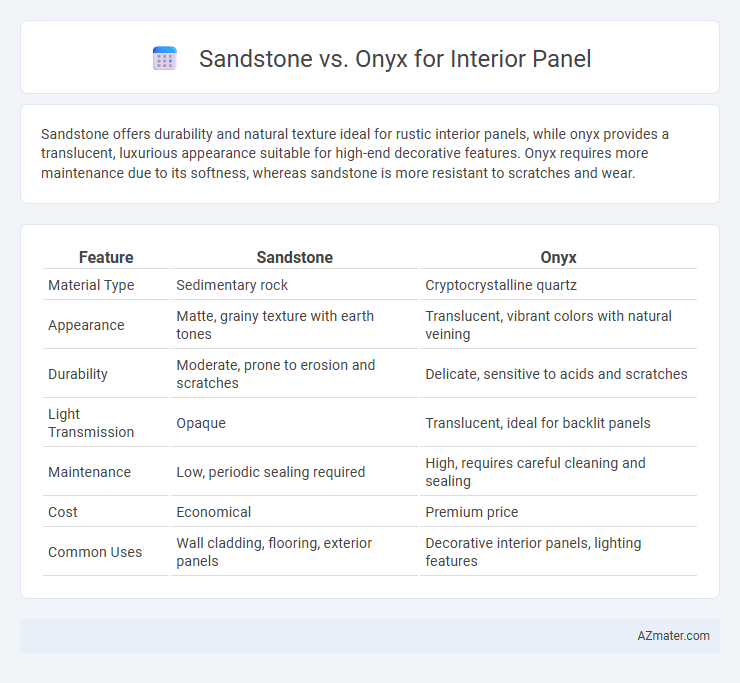Sandstone offers durability and natural texture ideal for rustic interior panels, while onyx provides a translucent, luxurious appearance suitable for high-end decorative features. Onyx requires more maintenance due to its softness, whereas sandstone is more resistant to scratches and wear.
Table of Comparison
| Feature | Sandstone | Onyx |
|---|---|---|
| Material Type | Sedimentary rock | Cryptocrystalline quartz |
| Appearance | Matte, grainy texture with earth tones | Translucent, vibrant colors with natural veining |
| Durability | Moderate, prone to erosion and scratches | Delicate, sensitive to acids and scratches |
| Light Transmission | Opaque | Translucent, ideal for backlit panels |
| Maintenance | Low, periodic sealing required | High, requires careful cleaning and sealing |
| Cost | Economical | Premium price |
| Common Uses | Wall cladding, flooring, exterior panels | Decorative interior panels, lighting features |
Introduction: Choosing Between Sandstone and Onyx for Interiors
Sandstone offers durability and a natural, earthy texture ideal for rustic interior panels, while onyx provides a luxurious, translucent quality with vibrant veining patterns suited for sophisticated design statements. Sandstone's porous structure makes it suitable for high-traffic areas, whereas onyx requires careful maintenance due to its softness and susceptibility to scratching. Selecting between sandstone and onyx depends on balancing aesthetic preferences with functional demands in interior spaces.
Aesthetic Appeal: Comparing Visual Characteristics
Sandstone offers a warm, earthy aesthetic with its granular texture and natural, muted color palette, providing a rustic yet elegant appeal for interior panels. Onyx stands out with its translucent quality and vibrant, swirling veining, creating a dramatic and luxurious visual impact often highlighted by backlighting. The choice between sandstone and onyx depends on whether the design prioritizes subtle natural warmth or bold, striking visual contrast.
Durability and Strength of Sandstone vs Onyx
Sandstone offers superior durability and strength compared to onyx, making it a preferred choice for interior panels in high-traffic areas. Its dense composition provides excellent resistance to scratches, impacts, and weathering, whereas onyx is softer and more prone to chipping and scratching due to its crystalline structure. Sandstone's robustness ensures long-lasting performance and minimal maintenance, whereas onyx requires careful handling to preserve its aesthetic appeal.
Maintenance and Cleaning Requirements
Sandstone panels require regular sealing and gentle cleaning methods to prevent staining and erosion due to their porous nature. Onyx panels, being more delicate and softer, demand careful handling, specialized cleaning products, and protection from acid-based cleaners to maintain their polished surface. Both materials benefit from routine dusting and avoidance of abrasive tools to preserve their aesthetic appeal and structural integrity.
Cost Analysis: Budget Considerations
Sandstone offers a more budget-friendly option for interior panels, with costs typically ranging from $10 to $30 per square foot, making it suitable for large-scale projects with tight budget constraints. Onyx, known for its unique translucency and luxurious aesthetic, commands a higher price point between $50 and $200 per square foot, which can significantly impact overall project expenses. When considering installation and maintenance, sandstone requires less specialized care, further reducing long-term costs compared to the delicate nature and higher upkeep expenses associated with onyx panels.
Installation Process and Complexity
Sandstone panels require careful handling during installation due to their porous nature, often necessitating sealing before mounting to prevent moisture absorption and damage. Onyx panels, although more fragile and heavier, demand precise cutting and specialized mounting systems to support their translucency and prevent cracking. Both materials involve complex installation processes, but onyx typically requires more expertise and time to ensure a flawless, secure finish.
Environmental Impact and Sustainability
Sandstone is a natural sedimentary rock with low environmental impact due to its abundant availability and minimal processing requirements, making it a sustainable choice for interior panels. Onyx, a rare and more energy-intensive mineral, involves extensive quarrying and polishing, contributing to higher carbon emissions and resource depletion. Choosing sandstone over onyx for interior panels supports eco-friendly building practices by reducing carbon footprint and promoting resource conservation.
Suitable Applications in Interior Design
Sandstone offers a natural, earthy texture ideal for rustic or Mediterranean-inspired interior panels, enhancing spaces like living rooms, fireplaces, and feature walls with its durability and warm tones. Onyx, with its translucent and luxurious appearance, suits high-end applications such as backlit panels, bar fronts, and statement walls in modern or upscale interiors, providing an elegant ambiance through its vibrant color variations. Designers often choose sandstone for robustness and subtle aesthetics, while onyx is selected for dramatic visual impact and light diffusion in interior design.
Pros and Cons of Sandstone Panels
Sandstone panels offer excellent durability and a natural, earthy aesthetic that enhances indoor spaces with warm tones and unique textures, making them ideal for feature walls and fireplaces. However, sandstone is porous and prone to staining and water absorption, requiring regular sealing and maintenance to preserve its appearance and structural integrity. Compared to onyx, sandstone is more affordable and easier to install but lacks the translucency and luxurious appeal that onyx provides.
Pros and Cons of Onyx Panels
Onyx panels offer a unique translucency and vibrant color palette that can create striking interior features, making them highly desirable for luxury spaces. They are relatively soft and fragile compared to sandstone, requiring careful installation and maintenance to avoid scratches and damage. Despite their higher cost and susceptibility to etching from acids, onyx panels provide an unparalleled aesthetic appeal with a glossy finish that enhances light diffusion in interior design.

Infographic: Sandstone vs Onyx for Interior Panel
 azmater.com
azmater.com